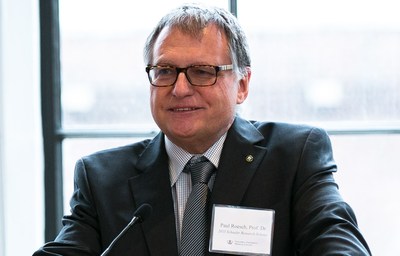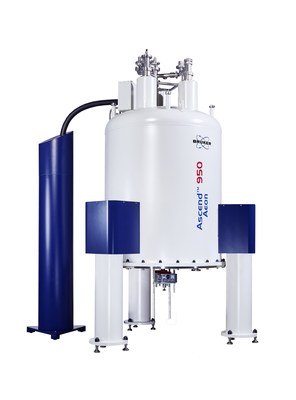Bruker Corporation Introduces Cutting-Edge NMR Magnet And Probe Technology At ENC 2016
PITTSBURGH, April 11, 2016 /PRNewswire/ -- At the 57th Experimental Nuclear Magnetic Resonance Conference (www.enc-conference.org), Bruker (NASDAQ: BRKR) announced new GHz-class NMR magnet and probe technologies to enable expanding frontiers in structural biology, membrane protein and intrinsically disordered protein (IDP) research.
World's first shielded 1 GHz NMR at University of Bayreuth: Bruker has successfully installed the world's first, next-generation 1GHz NMR system equipped with an actively-shielded Aeon 1 GHz magnet at the University of Bayreuth, Germany. Active shielding reduces the space requirements for the two-story magnet by more than an order of magnitude, and makes siting of next-generation Aeon 1 GHz magnets straightforward. The new Aeon 1 GHz magnets have been developed using advanced superconductors provided by Bruker's Energy & Supercon Technologies (BEST) division. The Aeon 1 GHz also features novel active refrigeration technology, eliminating the need for liquid nitrogen, and reducing liquid helium boil-off essentially to zero under normal operation. Bi-annual pulse-tube cooler maintenance is done at field for minimal disruption and downtime.

Professor Paul Rösch is the Director of the Research Center for Bio-Macromolecules at the University of Bayreuth, Germany, where the installation of the world's first Aeon 1 GHz system for high-resolution NMR was recently completed. Dr. Rösch stated: "The Aeon 1 GHz is a breakthrough for our studies of the interaction of transcription factors with bacterial RNA-polymerase. With a molecular mass exceeding 450 kDa, this is one of the largest heteromeric protein systems ever successfully studied by NMR. We were pleased with the smooth installation and the protein spectra look wonderful. The instrument will also advance our studies of G-protein coupled receptors and their interaction with membranes, a field of utmost importance to pharmaceutical industry."

The Aeon 1 GHz represents a milestone in the development of tools for the advancement of structural biology and IDP research. Due to its increased spectral dispersion and sensitivity, the system increases the size of bio-macromolecules that can be studied. The GHz systems are also the optimal platform for new CryoProbe technology and new NMR methods and pulse sequences for the study of intrinsically disordered proteins. Additional Aeon 1 GHzsystems are on order from the University of Toronto and the Weizmann Institute of Science.
Novel Single-Story Aeon 950 MHzat University of Leeds: the world's first compact, single-story 950 MHz NMR magnet for high-resolution protein NMR is being introduced at ENC 2016. It also integrates advanced refrigeration technology, and obviates the need for any cryogen refills. This new single-story 950 MHz magnet has been successfully installed at the University of Leeds, UK. Previous 950 MHz magnets required specialized two-story NMR laboratories.

For the Astbury Centre for Structural Molecular Biology at University of Leeds, the single-story Aeon 950 MHz magnet could be installed without building adaptations. It incorporates a novel CryoProbe now for both 13C and 15N direct detection. This compact ultra-high field magnet and probe technology enables the determination of structures, dynamics and interactions of globular proteins, as well as the study of advanced functional and disease mechanisms of intrinsically disordered proteins.
Dr. Alex Breeze, Professor of Biomolecular NMR at the University of Leeds, stated: "We are tremendously excited by our new Aeon 950 MHz instrument, which will be complemented with cutting-edge cryo-electron microscopy and other structural biology techniques. In particular, the combination of 950 MHz field strength and the novel direct-detection capabilities of the latest CryoProbes allow us to access critical structural and dynamic information on important biological systems and medically relevant targets with optimum sensitivity and resolution. Indeed, we have already obtained impressive 1H-15N TROSY data on unlabeled proteins at natural isotopic abundance expressed in mammalian cells on our new 950 MHz system."
New 15N-optimized CryoProbe: The recently introduced next-generation 15N optimized CryoProbes with cold 15N preamplifiers will now be offered up to 1 GHz. In conjunction with the latest GHz-magnets and novel 15N direct-detect NMR methods, this CryoProbe now makes direct 15N detection sensitive and advantageous in very large globular proteins and in IDPs, due to the longer relaxation times, high resolution and low chemical shift anisotropy of 15N spectra. Furthermore, 15N detection is beneficial in cases where carbon-detected methods suffer from multiple couplings to neighboring carbons, or in the study of proline-rich protein domains. Another attractive area of 15N detection are paramagnetic metallo-proteins, where 1H or even 13C magnetization is broadened beyond detection limits. These 15N-detected experiments are critically dependent on the high sensitivity delivered by new 5mm CryoProbes with cryogenic 15N preamplifiers. In conjunction with updated fast acquisition methods, experiment times are no longer a detriment to arrive at this information.
Professor Gerhard Wagner of Harvard Medical School, a pioneer of 15N direct detection, stated: "Direct 15N and 13C detection methods have recently been evolved and found to be almost as sensitive as 1H detection techniques, benefitting from the slow transverse relaxation. 15N-detected TROSYs in particular do not require protein perdeuteration, which avoids the confounding problem of incomplete amide back exchange in large proteins that cannot be refolded and open avenues for expressing [13C,15N]-labeled proteins in insect cells or mammalian systems. The low-gamma NMR detection methods also provide new opportunities for studies of proline-rich polypeptides often found in regulatory regions, such as phosphorylation domains. However, spectra of such domains are typically poorly dispersed and highest field strengths will be needed to reveal mechanisms of phosphorylation-dependent switch mechanisms. Availability of GHz-class NMR instruments will be important for revealing mechanisms of phosphorylation-dependent signaling switches."
Frank H. Laukien, Ph.D., President and CEO of Bruker Corporation, commented: "Now successfully installed at customer sites, the new GHz NMR technology is opening new frontiers for the study of IDPs in biology and disease pathogenesis. The GHz NMR tools will accelerate our understanding of many fundamental biological processes and help to illuminate the 'Dark Proteome'. The Aeon 1 GHz system, with its latest Cryoprobe technology and NMR methods, is expected to provide enormous benefits for clinical and pharmaceutical research on the role of globular, membrane and intrinsically disordered proteins in cancer, diabetes and neurodegenerative diseases."
About Bruker Corporation
For more than 50 years, Bruker has enabled scientists to make breakthrough discoveries and develop new applications that improve the quality of human life. Bruker's high-performance scientific research instruments and high-value analytical solutions enable scientists to explore life and materials at molecular, cellular and microscopic levels.
In close cooperation with our customers, Bruker is enabling innovation, productivity and customer success in life science molecular research, in applied and pharma applications, in microscopy, nano-analysis and industrial applications, as well as in cell biology, preclinical imaging, clinical research, microbiology and molecular diagnostics. For more information, please visit www.bruker.com.
For more information on Bruker at ENC 2016, please visit: www.bruker.com/enc
Photo - http://photos.prnewswire.com/prnh/20160407/352843
Photo - http://photos.prnewswire.com/prnh/20160407/352845
Photo - http://photos.prnewswire.com/prnh/20160407/352844
To view the original version on PR Newswire, visit:http://www.prnewswire.com/news-releases/bruker-introduces-cutting-edge-nmr-magnet-and-probe-technology-at-enc-2016-300248348.html
SOURCE Bruker Corporation

